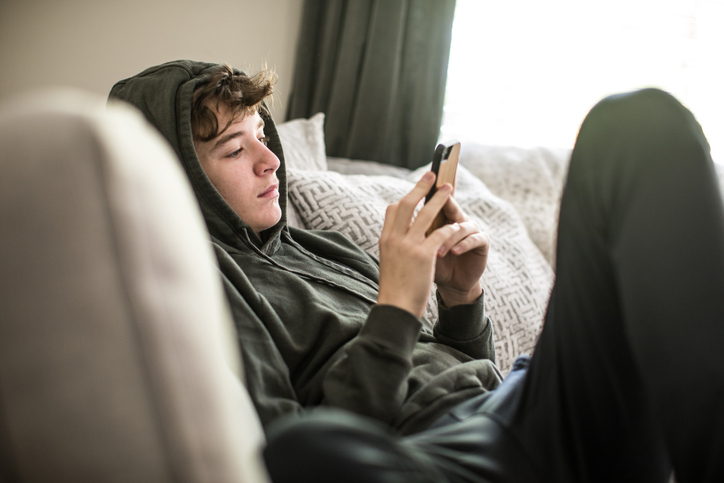
Teens and Screens: An Emerging Crisis
School is out and summer is officially here for much of America’s youth. And while the stress of classes and coursework has ended, the anxiety and damage caused by excessive screen time only increases. Longer days, coupled with higher temperatures and an influx of free time, lead many kids to spend a large portion of their day indoors and online, which can be extremely harmful to their mental health and well-being.
In fact, early data from a landmark National Institutes of Health (NIH) study indicates that children who spent more than two hours a day on screen-time activities scored lower on language and thinking tests, and those with more than seven hours of daily screen time even experienced a thinning of the brain’s cortex, the area related to critical thinking and reasoning. This is a sobering finding, especially with a recent Pew Research Center survey reporting almost half of U.S. teenagers say they are online “almost constantly.”
In recent years – coinciding with the explosion of social media – depression, anxiety, and loneliness among teenagers have risen at alarming rates, with nearly half of U.S. teens reporting to have been bullied or harassed online. And while bullying from classmates is certainly not a new phenomenon, previous generations could take refuge once the school day ended. Not so for today’s teens. Through social media and text messaging, these harmful taunts can continue unabated, 24/7, greatly heightening the abuse, humiliation, depression, and isolation.
The simple solution would be to just unplug. The truth is that it’s not quite that easy. Much of our kids’ coursework is now completed online. They communicate with friends via text, apps, and video, and consume their entertainment via YouTube, TikTok, Twitch, Instagram, and other platforms. Screens are ubiquitous in today’s world. From cell phones to televisions to computers and tablets, almost all our daily tasks and entertainment outlets lead back to a digital device or interface. For many, our first and last inclination before we go to bed and upon waking up is to grab the phone and “catch up,” harming our circadian rhythm and disrupting sleep patterns critical to mental health. If you’re not careful, “doom scrolling” can quickly turn a habit into a destructive norm.
As a parent in this increasingly online world, you may be unsure of how to best protect your child while giving them the space and freedom to grow and learn with independence. The situation can be overwhelming. Thankfully, there are organizations like Screen Sanity, which offer a helping hand to parents by providing actionable steps and resources that promote positive mental health for teens and children.
Screen Sanity, a local nonprofit organization based in Overland Park, Kansas, understands that managing a child’s screen time can be extremely challenging. With that in mind, they suggest implementing a screen-time plan for your family using the following guidelines:
Limit Screen Use When Possible
- For ages 6 and older, encourage healthy habits and limit activities that include screens.
- Turn off all screens during family meals and outings.
- Learn about and use parental controls.
- Avoid using screens as pacifiers, babysitters, or to stop tantrums.
- Turn off screens and remove them from bedrooms 30-60 minutes before bedtime.
Be An Active Participant
- Familiarize yourself with programming to make sure it is age-appropriate for your child.
- Talk to your child about what they are seeing. Point out good behavior, such as cooperation, friendship, and concern for others. Make connections to meaningful events or places of interest.
- Be aware of advertising and how it influences choices.
- Encourage your child to learn other activities such as sports, music, art, and hobbies that do not involve screens.
- Set a good example with your own safe and healthy screen habits.
- Teach children about online privacy and safety.
- Actively decide when your child is ready for a personal device.
- Encourage using screens in ways that build creativity and connection with family and friends.
- Consider your child or teen’s maturity and habits. The right plan for one family may not be a good fit for another.
Blue KC and Screen Sanity believe that positive and healthy screen use is possible with the proper guidance and consistency. It’s why, recently, a partnership was formed between the two organizations to help turn the tide of excessive screen use among America’s teens and kids.
“In 2021, Screen Sanity was thrilled to receive $50,000 from Blue KC to help achieve our long-term vision of creating a world where kids in Kansas City are captivated by life, not screens. This funding had a transformational impact on our organization, allowing us to step out of the start-up phase and into our first phase of scaling. Our two-part strategy focused on expanding to new audiences in the Kansas City metro and developing new content across three key areas of programming: training, tools, and tips. Highlights include our Screen Sanity Group Study book and videos, our Social Media Playbook, and multiple Screen Sanity Podcast episodes,”saidTracy Foster, Co-founder and Executive Director of Screen Sanity.
For those directly impacted by the daily challenges posed by excessive screen use, Screen Sanity has become a much-needed ally, offering support to those that need it most. While teaching parents how to pivot from reactive to proactive.
“Coming together with others who are fighting the same screen time battle was incredibly enlightening. The conversations were life-changing and wouldn’t have happened without the help of the Screen Sanity videos and discussion prompts. I feel hopeful now, not helpless,” a Screen Sanity Group Study participant said.
Blue KC is backing Screen Sanity in its mission again in 2023. Additional partnership initiatives are currently underway, including the rollout of a comprehensive, hour-long virtual workshop that helps parents create a family screen plan based on expert-guided content about digital health, and a “Parent’s Night Out” event that educates about the dangers of excessive screen use and ways parents can help stem the tide.
RELATED: Breaking the Stigma Around Teen Mental Health
Kristin Gernon LCSW LMSW, Behavioral Health Training & Development Specialist at Blue KC, believes there are ways to balance screen use with a healthy lifestyle.
“While the pervasiveness of digital devices continues to rise, there are proactive steps that families can take, like setting up screen-free zones in your house and taking an active interest in the content your children consume. It’s also very important to be a good role model when it comes to your own screen use. Parents and adults can learn a lot from the boundaries we set for our children as this issue impacts us all,” she said.
Gernon recommends parents check in on their children regularly while staying in close contact with teachers, counselors, and their primary care doctor or pediatrician. She also notes to always be on the lookout for the warning signs of behavioral health conditions associated with excessive screen time, which include:
- Withdrawing from friendships and other personal relationships.
- Mood changes and fluctuations.
- Disengagement in activities that previously brought enjoyment.
- Overly sedentary behavior.
Blue KC offers members additional support and resources related to this issue, including a free training course offered to all employer groups (“Online Safety in the Age of Social Media”) as well as round-the-clock access to a personal Mindful Advocate (833-302-6463).
As technology continues to evolve at a breakneck pace, our children are faced with an increasingly complex digital landscape that can leave them vulnerable and overwhelmed. And given that societal reliance on devices is here to stay, it’s critically important to help our children and teenagers develop a healthy relationship with the digital content they consume. Through awareness, communication, and setting consistent boundaries, parents can turn the tide of excessive screen use while promoting a healthier household for the entire family. But you don’t have to do it alone. Utilize the resources outlined above, and don’t be afraid to ask for help. Together, we can reduce excessive screen use, improving the mental health and well-being of ourselves and our children.


